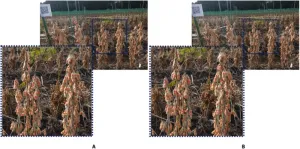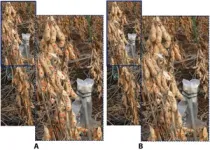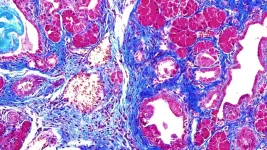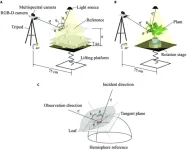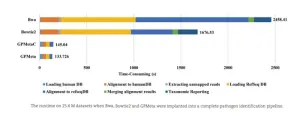(Press-News.org)
Farming is one of the oldest activities in the world and has always been at the forefront of technological innovation. With mechanized equipment, modified seeds, and digital devices, every aspect of farming, from planting to harvesting is gradually getting optimized. These benefits have also translated to better crop yield estimation for crops such as soybean. Deep learning-based yield estimation models use approaches like regression, traditional bounding boxes, or density maps to make counting of seeds easier. Compared to manual counting, these methods are undoubtedly simpler, more accurate, and easy to implement.
“P2PNet” is one such automated counting method which was recently proposed to simplify point counting of soybean seeds. However, this method demonstrated low performance for direct seed counting. Disturbance from background objects, substantial overpredictions, use of high-level features, and unaccounted scale of objects were identified as some drawbacks of this model. To counter the challenges associated with this model, researchers from Japan have developed a new model that adds to the list of agricultural technological innovations. It accurately counts the number of soybean seeds from field images of soybean plants, eliminating the labor-intensive seed counting process. The study was led by Associate Professor Wei Guo of the University of Tokyo and was published online in volume 5 of Plant Phenomics on 15 March 2023.
“Soybean is an important protein source for animals and humans. Therefore, achieving high crop yields is a common criterion and goal in most breeding programs,” explains Prof. Guo.
The seed count is of particular interest to farmers as it can be used to ascertain both, the plant's yield and its breeding potential. Traditional image-based automated seed counting methods keep track of seeds in images by placing them in bounding boxes. However, in actual field conditions, the presence of complex backgrounds, overlapping pods, and varying lighting conditions can cause the bounding boxes to overlap, leading to inaccuracies in the seed count and position.
Addressing these challenges, the team upgraded P2PNet to the new, improved model “P2PNet-Soy”. It counts objects by identifying them as small points in the image. To obtain data for training the model for soybean seed identification, the researchers took 374 images of soybean plants grown in a field. They photographed two sides (front and back) of the plant to capture maximum seeds in the plant. Next, skilled technicians from the Field Phenomics Lab at the University of Tokyo carefully marked the seeds present in each soybean pod with dots. They ensured that only the seeds belonging to the target plant were annotated and those from neighboring plants and the background were excluded. The researchers then selected 181 images for training and used the other 193 images, which were taken from the opposite side, to evaluate the model.
The researchers adopted several strategies to improve the performance of the model. First, both high- and low-level features were captured from the field images. The high-level features generally consider the context of the objects in the images, while the low-level features are much more useful in recognizing details and smaller objects. A scale-invariant feature extraction method known as atrous convolution was then used to enable the model to detect seeds of different sizes. In addition, spatial and channel attention mechanisms were applied to better differentiate the seeds from the background. The research team refined the predictions of the model by applying a postprocessing technique called k-d tree, an unsupervised clustering algorithm that determines the centers of closely located predicted seed locations, boosting the accuracy of the final prediction.
These improvements resulted in an accurate seed counting and localization model that could detect and count seeds from simple images of soybean plants taken in the field. “The upgraded P2PNet-Soy method for more effective soybean seed counting and localization has much higher accuracy in comparison to not only the original P2PNet but also other soybean pod counting method,” says Prof. Guo.
Even as these improvements result in improved accuracy of seed prediction, the model has a few limitations which require redressal. Since the model is trained on images taken from both sides of the same plant, it can overestimate the number of seeds on the plant. Additionally, the model cannot detect seeds that are accidentally missed in the image.
Nevertheless, the development of such advanced technologies is a promising step towards a more efficient agricultural industry.
###
Reference
Authors
Jiangsan Zhao1, Akito Kaga2, Tetsuya Yamada2, Kunihiko Komatsu3, Kaori Hirata4, Akio Kikuchi4, Masayuki Hirafuji1, Seishi Ninomiya1, and Wei Guo1*
Affiliations
1 Graduate School of Agriculture and Life Sciences, The University of Tokyo
2 Institute of Crop Sciences, National Agriculture and Food Research Organization
3 Western Region Agricultural Research Center, National Agriculture and Food Research Organization
4 Tohoku Agricultural Research Center, National Agriculture and Food Research Organization
END
Using hydrophones to eavesdrop on a reef off the coast of Goa, India, researchers have helped advance a new low-cost way to monitor changes in the world’s murky marine environments.
Reporting their results in the Journal of the Acoustical Society of America (JASA), the scientists recorded the duration and timing of mating and feeding sounds – songs, croaks, trumpets and drums – of 21 of the world’s noise-making ocean species.
With artificial intelligence and other pioneering techniques to discern ...
Pancreatic ductal adenocarcinoma (PDAC) is the most common form of pancreatic cancer. It’s also one of the deadliest. More than 90% of PDAC patients die within five years of diagnosis. Usually, by the time the cancer is identified, it has already spread.
“PDAC is often found too late for treatments like chemotherapy and surgery to be very effective,” Cold Spring Harbor Laboratory (CSHL) Professor Adrian Krainer says. “But if we can clearly understand the underlying genetic mechanisms of PDAC, this might lead to earlier diagnoses and new types of therapies.”
Krainer ...
Modern cameras and sensors, together with image processing algorithms and artificial intelligence (AI), are ushering in a new era of precision agriculture and plant breeding. In the near future, farmers and scientists will be able to quantify various plant traits by simply pointing special imaging devices at plants. However, some obstacles must be overcome before these visions become a reality. A major issue faced during image-sensing is the difficulty of combining data from the same plant gathered from multiple image sensors, also known as ‘multispectral’ or ‘multimodal’ ...
Metagenomic sequencing (mNGS) is a powerful diagnostic tool to detect causative pathogens in clinical microbiological testing. Rapid and accurate classification of metagenomic sequences is a critical procedure for pathogen identification in the dry-lab step of mNGS tests. However, this crucial step may be improved by classifying sequences within a clinically relevant timeframe.
To address this challenge, a BGI Genomics team led by Xuebin Wang has recently launched GPMeta, an ultra-fast pathogen detection approach, and published these highlights ...
In the United States suicide has become the second leading cause of premature death among those ages 10 to 24; it is the leading cause of death among teens ages 13 to 14.
Researchers from Florida Atlantic University’s Schmidt College of Medicine and collaborators conducted a study exploring trends in rates of suicide among 13 to 14 year olds in the U.S. from 1999 to 2018. They also explored possible modifications by sex, race, level of urbanization, census region, month of the year and day of the week.
Results, published online ahead of print in the journal Annals of Pediatrics and Child Health, showed that among children ages 13 to 14, suicide rates ...
Researchers from University of Notre Dame and The Ohio State University published a new Journal of Marketing study that examines how the use of unconventional spellings of a brand name impacts consumers’ inferences about and willingness to support the brand.
The study, forthcoming in the Journal of Marketing, is titled “‘Choozing’ the Best Spelling: Consumer Response to Unconventionally Spelled Brand Names” and is authored by John P. Costello, Jesse Walker, and Rebecca Walker Reczek.
Choosing a brand ...
Development of vaccines against SARS-CoV-2 has been rapid, but the rise of variants forces scientists to frequently modify treatments. Ideally, therapies would target mutation-resistant viral proteins, but this has proven difficult. Researchers reporting in ACS Central Science, however, have now developed a system that directly targets and degrades the viral RNA genome, reducing infection in mice. The method could be adapted to fight off many viruses, as well as treat various diseases.
Vaccines and antiviral drugs typically target proteins critical to viral infection and replication. This ...
Research Highlights:
U.S. adults who reported feeling highly discriminated against at work had an increased risk of developing high blood pressure than those who reported low discrimination at work.
Researchers suggest government and employer anti-discrimination policies and interventions may help to eliminate discrimination in the workplace.
Embargoed until 4 a.m. CT/5 a.m. ET Wednesday, April 26, 2023
DALLAS, April 26, 2023 — U.S. adults who reported feeling discriminated against at work had a higher risk for developing high ...
Safer and more effective blood thinners could be on the way following a groundbreaking discovery by researchers at UBC and the University of Michigan, published today in Nature Communications.
By combining their expertise in blood clotting systems and chemical synthesis, the researchers have designed a new compound called MPI 8 that offers the potential to prevent blood clots without any increased risk of bleeding—a common side effect of existing blood thinners.
“The development of MPI 8 represents a major breakthrough in the field of blood clot prevention and treatment,” said Dr. Jay Kizhakkedathu, a professor and Canada Research ...
Researchers at the Francis Crick Institute, King’s College London and University College London have shed light on the genetics behind changes in the structure and shape of the face and head in a mouse model of Down Syndrome.
Described in a paper published today in Development, the researchers found that having a third copy of the gene Dyrk1a and at least three other genes were responsible for these changes taking place in development – called craniofacial dysmorphology – which involve shortened back-to-front length and widened diameter of the head.
Affecting ...
